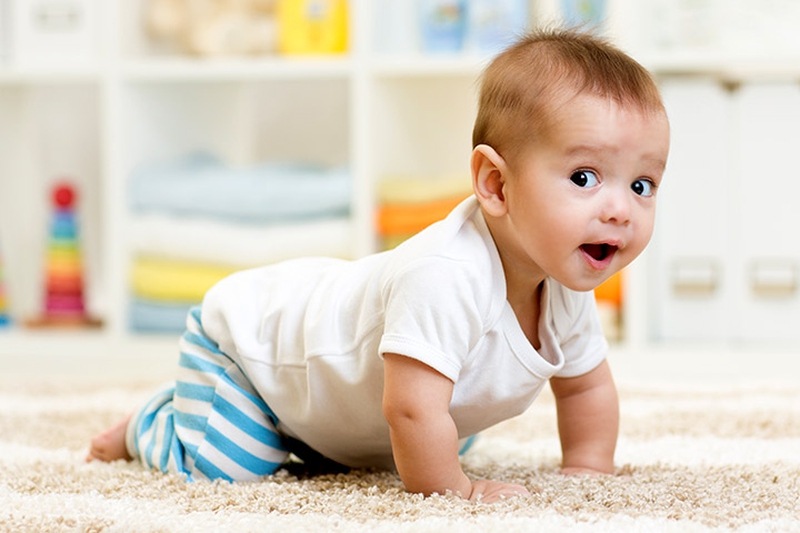As a parent, it is normal to want to make sure that your baby reaches all of his milestones in a timely manner, which leads to many parents wondering when babies crawl. The answer varies from baby to baby as everyone is unique. In general, babies will begin to crawl between about 7 and 10 months, but you shouldn’t worry if yours hasn’t started yet at this age. The more you learn about when babies crawl, the better prepared you will be to encourage this milestone and keep your baby safe.
When Do Babies Crawl?
As mentioned, the average age that babies start crawling at is around 7-10 months. That being said, some babies prefer other methods of getting around independently instead of crawling. Some will roll around the room while others will slither on their stomachs and yet others will bottom shuffle, which involves scooting around on their bottoms with hands in the back and a feet in the front to help with the movement.
Development Steps Towards Crawling
Your baby won’t suddenly just be able to crawl. Like all other developmental milestones, this one occurs in stages. Your baby will first start balancing on his knees and hands. After this, he will likely learn how to move forward or back by pushing off of his knees. Then, he will move onto crawling. Throughout this entire learning process, your baby will be strengthening the muscles he needs to walk eventually.
In addition to working on strengthening his muscles and learning how his limbs coordinate, your baby will have to work on understanding his vision before he can crawl. During crawling, your baby uses binocular vision, which means using both of the eyes together in order to focus on a target. Crawling also involves looking into the distance followed by at their hands, something that helps with depth perception.
How to Encourage Your Baby to Crawl
Tummy Time
Tummy time is when you put your baby onto his tummy and play with him in that position. This should be done multiple times a day for a few minutes at a time while he’s alert. This helps develop muscles necessary for crawling and can prevent him from developing a flat spot on his head.
Place Objects Strategically
You can also encourage your baby by giving him an incentive to reach a point. Put yourself or a favorite toy just out of reach so he wants to try crawling. You can even create an obstacle course with sofa cushions and pillows to work on agility and speed; just never leave your child alone.
What to Expect as a Parent
When do babies crawl? You already know the timeline. As a parent, you should expect your baby to start getting interested in crawling as soon as he can sit up without support, which is typically by 4-7 months. At this point, you can expect your baby to hold up his head and look around. The muscles in his legs, arms, and back will be strong enough as well to prevent him from falling onto the floor when on his knees and hands.
During several weeks/months, your baby will gain confidence in moving from sitting still to all fours then realize that he can rock forth and back while the limbs are straight and his body is parallel with the floor. At about nine or ten months (sometimes earlier), your baby will most likely realize that by pushing off with the knees, he gets enough force to get moving. Eventually, he will also learn to go back from crawling to the sitting position.
After mastering regular crawling, your baby will likely conquer “cross-crawling.” This is one moving opposite arms and legs when going forward instead of the arm and leg from the same side of the body, which is how he likely started. Most babies become competent crawlers by about one year of age.
Precautions to Take to Keep Crawling Babies Safe
As soon as your baby shows any signs of crawling, it is time to childproof your home, particularly for your baby’s safety. Stairway gates should be at the top of the list as should be moving any dangerous objects on low shelves out of reach. Stairs should remain out of reach until your baby is an excellent walker and even then, require supervision. In the meantime, he can practice with stairs you make out of foam blocks.
Milestones to Expect Afterwards
Crawling is one of many major mobility milestones. Shortly after learning to crawl, you should expect your baby to start pulling himself up with everything in reach. Once he begins to feel balanced, he will stand by himself then cruise around on furniture. From there, he will move to walking and be running or jumping before long.
My Baby’s Not Crawling, Should I Be Concerned?
Remember that not all babies choose to crawl. Some will skip crawling and go with a different method of movement. As long as your child is using both legs and arms equally and working on coordination between them, you have no reason to worry. Your baby may also just be learning to crawl later on in life. The Back to Sleep campaign that started in 1994 to fight SIDS and encourages parents to have their babies sleep on their backs has actually pushed back the initial age of crawling somewhat.
Additionally, other babies will not crawl at all. Some will skip this step entirely ruining the question when do babies crawl. Instead, they will go right to pulling themselves up, standing, cruising (walking with the help of furniture), and walking. Every baby is unique.
The only thing to keep in mind is that if your baby isn’t showing any interest in mobility or coordination of his arms or legs by age one, let his doctor know.

View All Comments /Add Comment